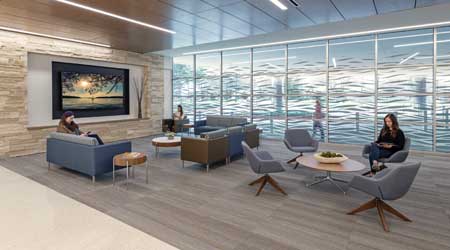New Tech and Design Trends Shape Healthcare Facilities
Evidence-based design has emerged as a driver for healthcare facilities. Here are several trends facility managers should be aware of to increase patient satisfaction.
It is difficult to deny the correlation between the look and feel of an environment and its tangible, quantifiable impact on the people who inhabit it. A well-designed workplace can surely make workers more productive, for instance, and an engaging, entertaining retail store encourages shoppers to buy more things. Makes sense. But if those benefits do emerge, how do we prove design had anything to do with it? Nowhere is the relationship between environment and impact more of an issue than in the design of healthcare facilities, where the creation of a healing environment — a place that truly and demonstrably helps cures the ill — has become the Holy Grail for facility managers and designers.
An approach known as evidence-based design has emerged as a driver of healthcare architecture and is one of the key emerging trends that advance the correlation between a healing environment and positive clinical outcomes. A few traditional elements — color palette, access to natural light, wayfinding — are at the core of the discussion about current trends, but it’s also it’s also important to be aware of some non-traditional elements that are starting to add new contour to current thinking.
At its root, evidence-based design drives an environment that is therapeutic, supportive of family involvement, efficient for staff performance, and restorative for workers under stress. It has become the new currency of design around the globe, yielding data on the degree to which specific elements and approaches — from natural light and views of the outdoors to colors, signage, public art, and other aesthetics — encourage positive outcomes.
A pioneering 1984 study conducted by Roger Ulrich showed that surgery patients with a view of the outdoors and natural light suffered fewer complications, used less pain medication, and were discharged sooner than those with no view. Research by others shows that heart patients with strong social support systems survive longer post-discharge than those without.
Experience suggests that creating an environment that contributes to improving clinical outcomes is a combination of “hardware” solutions (i.e., those things that have to do with the built environment and aesthetics) as well as “software” (i.e., those operational issues that address the running of the hospital) and, of course, quality of care.
In other words, design per se is not the solution; design must work alongside (and be informed by) an operational understanding of the facility. Indeed, good healthcare designers have always known their work most go beyond “looking good” by also advancing an operational or functional purpose. Form does not follow function; form and function are interchangeable.
That interplay of form and function can be seen in these trends in healthcare interior design that facility managers should be aware of — trends that often show the new focus on evidence as the basis of design.
Related Topics:













